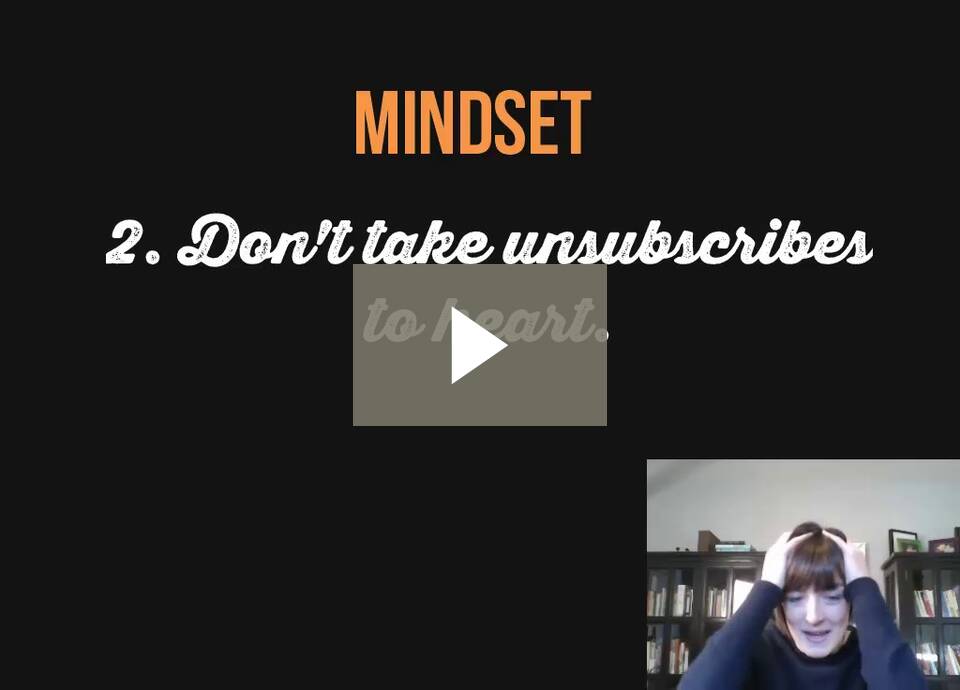How Can Live Videos Help You Get Leads
Use teasers
“To attract potential leads, promote your live video with a catchy title or appealing topic. Then as you cover the topic in the video, structure the presentation so it leads viewers into your marketing and sales funnel and takes advantage of the interaction that live video offers,” wrote Social Examiner.
When you structure a live video, you want viewers to stay until the end when you pitch your product or service. Therefore, make sure you give them an introduction and explain what you plan to discuss, offering them a hook to what they might miss if they don’t watch until the end. That will keep them connected and wanting to hear and see more.
Landing pages
Landing pages are meant for conversion. But that can only happen if the videos on them are able to attract their target, by being catchy and engaging. Video can help you do this by luring people in through humor or captivating storytelling. Videos are 12 times more likely to be watched than text is to be read. By creating an interesting video you will be able to keep the people longer on your landing page and convince them to continue on to the rest of your landing page content.
The best practice for capturing leads when using promotional videos on landing pages is to use a call-to-action (CTA) or auto-redirect. A CTA at the end of your video invites viewers to take the next step and an auto-redirect sends viewers to the rest of your landing page immediately upon completion, thus giving them the opportunity to further engage with your brand.
YouTube Annotations and other forms of pop-out CTAs are great additions to make sure your viewers are engaging with your content. You want your viewers to take action, and including these elements during a video is a great way to engage them in the moment—for example, if you are discussing a particular service or product and that annotation text link pops up right at that moment. Moreover, this is a great way to link people to other content you want them to view.
Offer demos of your products
One-off demo videos represents a great way to answer a question or highlight a specific product feature while engaging with leads in a personalized, helpful way. And more than anything, they are a really effective way of interacting.
Product videos are some of the most commonly produced and most frequently viewed videos. Rather than just capturing the standard information of name, company, email address, and phone number, use these types of videos, instead, as opportunities to learn more about your prospects. as the ultimate goal is to capture information that will help you to better qualify your leads. In order to succeed at that chapter you must make sure your videos contain interactive elements such as survey questions or polls, that will encourage your target to engage more.
Ask your audience to respond through a live chat bar, as this will give you the opportunity to see if they’re interested in the product or service you have to offer. This tactic will help you follow up with the right people after the live video ends and make more sales.
Offer educational, high-value content
People are drown to great content,from which they can learn more. Don’t make your live video just a sales pitch, make sure that at the end of the day the people watching are left with great pieces of information. That will make them come back to you over and over again.
Give discounts
Videos sale better than images, just as images sale better than plain texts. Therefore, don’t forget to offer people discounts if you are promoting a product or a service. This is a great way to attract new consumers, but also to keep the ones you already have. By giving the discounts only to the people watching the live video, it also offers them the feeling of exclusivity we all crave for.
How To Know If Your Webpages Are Keyword Relevant
More than ever any brand should want relevance and efficiency. Those should be words that stand out and make it count.
Therefore, when it comes to the online presence and how is your website performing, how do you know if the “Father” of all searches consider yours relevant or not? One of the best ways to see the ranking potential for a webpage is to see what it already ranks for. The first step is to pull the phrases you currently rank for. After having the basic ranking data, the next step is looking very carefully at the data and finding the additional keyword sets. To do this, you must focus on the phrases the site ranks for (in the top ten) and then count of all the individual words included with those keyword phrases. After looking for a certain phrase and seeing how your website ranks you must do the same search in the case of your competitors.
“Do you show up for a number of related phrases? If yes, then your target keyword is probably fairly possible for you to rank for, even if you don’t currently show up in the top 50 for that target. If you’re ranking for related words, Google at least sees you as being relevant,” explains Search Engine Land.
When the data appears to be in your favor and you are ranking for numerous related phrases, then it is relatively straightforward on how to proceed. According to webdetail, it will consist on tweaking some things, as you will need to improve your content to improve its depth. This includes the target page as well as any supporting content. It may be possible to conduct some public relations and link building in order to support your standing as a relevant source.
If you did not rank for many related terms, then your next steps are somewhat similar to tweaking. However, you will simply need to do so with more intensity. An overhaul will be necessary due to the fact that Google is not seeing your web pages as relevant to the keyword or topic. What this means is that the process will be more expensive and the results will take longer to appear. If you do not currently have the time or budget for something like this, then it may be wise to consider approaching a new target keyword,” added webdetail.com.
Here are some tips on how to boost your listing, according to Forbes.
How To Engage With Your YouTube Subscribers To The Full Potential
Over the years, YouTube has become the go-to place for content creators to showcase their amazing work to a massive audience. YouTube gets over 30 million visits a day, according to blog.elink.io. And in a period of time when Facebook is pushing a lot on video content, YouTube decided it’s high time it got back on its target radar as the number one video platform out there. Therefore, one of its moves was creating YouTube Community, a place for YouTubers to interact with their fans and followers in a very friendly environment. The YouTube Community gives creators a space to post various types of status updates – polls, pictures, text, GIFs, links and more. Subscribers and other visitors can then like or comment on these posts.
At launch, YouTube had extended the feature to just a few creators, and, according to engadget.com, the rollout has been slow ever since. But the response has been pretty positive and YouTube said it planned to add more channels following the launch. And, in fact, at the end of November last year, YouTube today announced that its Community feature is available to anyone who has a channel with more than 10,000 subscribers. The YouTube Community tab replaces the Discussion tab, the place where creators and viewers used to have general conversations. The main difference between the Community tab and the Discussion tab is that the Discussion tab was purely text-based, whereas the Community tab allows a variety of posting and discussion capabilities.
To get inspiration for your own community posts, follow the community posts of channels you subscribe to by visiting their Community tab or by viewing the Subscriptions tab of the YouTube app.
“It’s extremely important to engage with your users in the comments section. Try to respond to every comment you get; not only will this help your video engagement, it’ll help you mold your community as you see fit. Also, the more engaged a specific user is with your channel, the higher the likelihood that your videos will make it into their emails and notifications,” wrote Jayson DeMers for Forbes.
How to use the community tab feature to its best capacities? Here are some steps that will help you along the way:
- Tell your followers about the new feature and how you intend to use it, for them. To add a link to your Community tab in the video description, open the tab and copy the URL from your browser’s address bar. Share the video on your Community tab to make sure first-time visitors to this tab know what they can do to engage with your channel.
- Reach more. Try cross promoting other channels and creators, or promote your own second channel through the Community tab. This is a handy way of increasing your reach and letting people know about the other content that you care about.
- Make sure your subscribers enable the notifications. You may use a video or a community post (or both) to let subscribers know how to get notified about your latest channel activity. Tell them that they need to click the bell icon to the right of the button they use to subscribe.
- Use polls to get to know more about your target. Polls are a great way in which you can easily find out if they liked your video or not or what they want to see next. You can then refine your content based on their suggestions and provide more quality content to your audience.
- Promote your products. “Post a status update to the tab with an image of your product and a link to the product’s sales page. Consider creating a special landing page on your website for your channel subscribers and offer an exclusive discount just for YouTube visitors to measure the results,” said socialmediaexaminer.com.
- Create teasers with the following content of your videos or/and of important launches and events you have for your brand. Offering this exclusive new content will spark their interest and get them on your channel when you launch the new finished product or service. At the same time,you can also promote successful past videos for the people that haven’t seen them yet.
- Share exclusive GIFs and memes. Don’t forget we all want to have fun and enjoy our lives and we were drown to the social media platforms because they offered just that. A brand that can show emotion and humor is a brand that will always win people’s hearts and one that they can relate to.
Main questions before planning a marketing research
A marketing research done right needs planning and the important and right questions asked on time.Therefore, we decided to show you some of the questions we believed you should make sure you ask yourself,your department and your business,prior to starting a marketing research.
- What do I want to achieve with the marketing research?
- Do I need help with it? / Do we need to hire a research company?
- How can I reach my target?
- What other organizations have asked and answered comparable question to ones I have?
- What experts have insights into the questions we want to answer?
- Are there industry associations with ideas on answers or research methods to make us smarter?
- Are there other organization’s surveying our audience that might allow us to include some questions?
- Could I propose a joint research project with another organization to satisfy our mutual needs?
- Are there university programs where students can conduct research for us?
- Is the target market winning anything out of my business?
- Is the target market easy to be managed or how hard is it to be managed?
- Whom is my main competition?
How to speak marketing for the Generation Z?
If you still haven’t figured out the Millennials yet is high time you do it, because there is a new generation coming your way: one that is even younger and closer to technology then the Millennials. Unlike Millennials who are stereotyped as self-involved and demanding, the New York Times calls Gen Z “conscientious, hard-working and mindful of the future.”
According to yourcareerintel.com, more than a quarter of America’s population belongs to Gen Z, giving it a slight edge in size over Baby Boomers (23.6%) and Millennials (24.5%), reports US Consultancy Sparks and Honey. While much of this generation is still in their teens, they’re eager to start working. Parents of Gen Z are encouraging their children to find jobs early and independently, without their help. “Gen Zers are highly driven to achieve and more than half of all high school students are eager to gain independent job experience. College students are loading up on internships and summer positions to hone in on their dream job post-college,” added yourcareerintel.com.
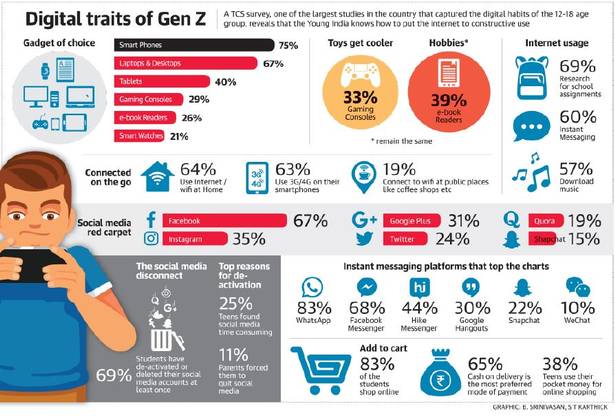
source: The Hindu
Who are they?
According to Wikipedia, Generation Z or Gen Z (also known as iGeneration or iGen, Post-Millennials, or Homeland Generation) is the demographic cohort after Millennials. Currently, there are numerous additional competing names used in connection with them in the media, demographers and researchers typically use the mid-1990s to mid-2000s as starting birth years. At the present time, there is little consensus regarding ending birth years. Moreover, most of Generation Z have used the Internet since a young age, and they are generally comfortable with technology and with interacting on social media.
“Gen Z lives in a world of continuous updates. Gen Z processes information faster than other generations thanks to apps like Snapchat and Vine. Thus their attention spans might be significantly lower than Millennials. Gen Z can quickly and efficiently shift between work and play, with multiple distractions going on in the background…working on multiple tasks at once. Gen Z are entrepreneurial and know the true value of independence, and knowledge is no exception here. If a Gen Z’er knows they are capable of learning something themselves, or through a more efficient, non-traditional route, you can bet they’ll take the opportunity,” wrote Huffington Post.
Meagan Johnson, a generational expert, speaker and author of From Boomers to Linksters: Managing the Friction Between Generations at Work, defines anyone born after 2002 (and therefore post-millennial) as the Linkster generation. “We chose the term Linkster Generation because it is the first generation to be linked into technology from day one. Millennials brought technology into the cultural focus and have pushed other generations to use technology. However, there are Millennials that can remember using dial up or even a life before social media,” Johnson told The Independent.
Therefore, the Linkster population – estimated to make up 18 per cent of the world’s population – grew up with social media, smart phones and apps. According to Johnson’s intervention for The Independent, the Linkster Generation may never hold a textbook, read everything from a tablet and never learn cursive writing and it may never write a check or walk into a traditional bank.
When it comes to their consumption on social media, Business Insider quoted the data gathered by a study conducted by the research firm 747 insights, in partnership with consumer research platform Collaborata, showing that only 49% of Gen Zers agree with the statement “Social media is an important part of my life” — a truth 61% of Millennials admit to. However, nearly 60% of both generations are concerned that social media is too public and that their posts could come back to haunt them. For Gen Z, this concern has changed its behavior: Members favor Snapchat in part because of the strict control over who can see their posts.
More on the study’s results you can read here.
Moreover, in November, a Piper Jaffray survey found 47% of teens consider Snapchat their favorite social media platform, up from 35% the year before. Instagram was the preferred platform for 24% of teens, the same number as one year earlier. Meanwhile, only 9% of teens chose Facebook — a decline of 4% from 2016. And that just after in September, market research firm eMarketer estimated that the number of Facebook users between the ages of 12 and 17 would be to fall 3.4% to 14.5 million people by the end of the year.
Gen Z is pragmatic and realistic, but they also believe it is possible to achieve their “dream job” and build a career doing what they love. Nearly a third of Gen Z (32%) said their greatest aspiration is to be at their dream job 10 years from now, according to Fortune. They’re realistic about how tough it may be to find this job, however. An equal amount (32%) say that finding a job is their top concern.
All of these data and more must be very well looked at and perceive by marketers in order to make sure that their campaigns will fit like a glove the wanted target.
Xennials – a new generation to be targeted by marketers
Typically born between 1977 and 1983, the generation remembers a childhood of dial-up internet and brick-like mobile phones, but was young enough to embrace the first wave of social media in their twenties. Xennials grew up with technological advances, and tend to be more comfortable with them Generation X.
Xennials are considered less cynical and pessimistic than Gen X, variously defined as being born from the mid 1960s to early 1980s, but not as optimistic and even entitled as Gen Y, born from the early 1980s to late 1990s.
According to Inverse.com,while Xennials are fluent in modern digital culture, they aren’t chained to it and “have some ability, or at least a latent space in our brains, to unplug.” Economically, “Xennials have seen it all”. They are old enough to remember the end of a long period of growth (following a small recession) in the 1990s, but they came of age around the time that the “dot-com bubble” burst and saw the decline and major recession of the 2000s. In other words, they were “first given a sweet taste of the good life, and then kicked in the face.”
Still, if you are not sure if you are Xennial or not and want to make sure, The Guardian even has a quiz for you that you can find here.
According to Professor Woodman of the University of Melbourne, the psychological makeup of the typical Xennial should lie somewhere between the typical Millennial and the members of Gen X. “The idea is there’s this micro or in-between generation between the Gen X group – who we think of as the depressed flannelette-shirt-wearing, grunge-listening children that came after the Baby Boomers and the Millennials – who get described as optimistic, tech savvy and maybe a little bit too sure of themselves and too confident.”
On their turn, the writers at Hiring Monster consider that Xennials and Millennials love to feel a sense of pride in what they’re doing; they’re not driven by salary alone. They might eventually pursue their own projects and go freelance, but they feel accountable for their work and take ownership in it. “They don’t see their jobs as “punch in, punch out” or 9 to 5; they live and breathe their work.”
So how are you as marketers embracing them?
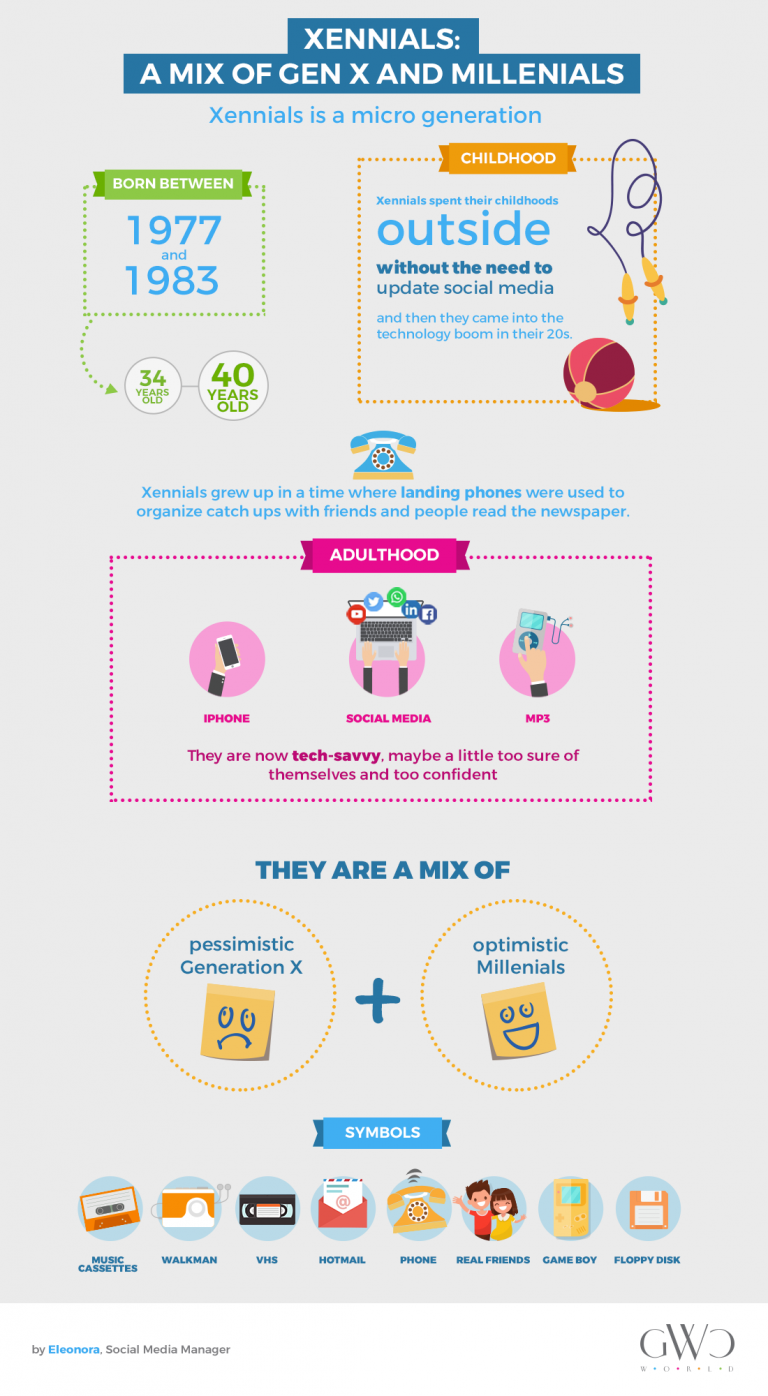
How to create an online storytelling campaign for an NGO
“Storytelling is how humans communicate with each other, the way that we make sense of complex information, and how we relay our experiences to others. Nonprofit storytelling can motivate people to pay attention and take action. Emotional, appealing stories can build an online audience for your nonprofit,” wrote TheBalance.
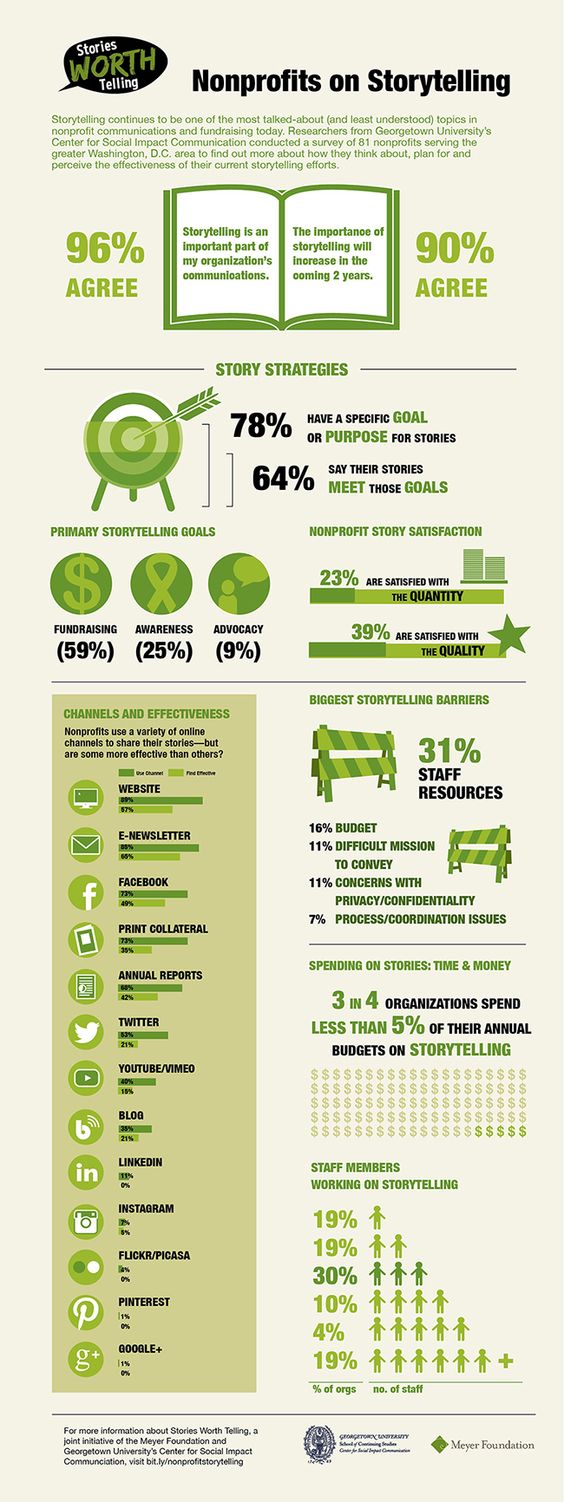
Videos allow you to combine your dynamic story with emotion to create a connection with your audience that words and photos cannot build. Emotion is your main asset to use. Moreover, organizations can convey impact in a way that engages and inspires donors by persistently telling stories.Through storytelling, nonprofit organizations can harness the power of emotion to make a connection with donors that inspires action.
According to thebalance.com, a storytelling campaign has three phases: planning, implementation, and evaluation. In the planning stage, you need to articulate the goal of the storytelling campaign clearly. “Design each campaign for a defined purpose and to accomplish a specific goal. You may need to carry out multiple storytelling campaigns per month to achieve your goal, or perhaps just one per quarter, depending on your resources. Once you define the action that you want people to take, you can determine who is most likely to take that action, and the emotional storytelling hooks to get them to do so.”
The next steps are selecting your audience and making sure that the story is true and it fits the audience’s expectations and realities. There are five main types of stories that nonprofits can collect and develop — value stories, social proof stories, founder stories, resilience/continuous improvement stories, and impact stories. After deciding that you must collect the necessary pieces of information to create the right campaign, choose the right channels to whom to send it and promote it,create it, share it and evaluate it. More details you can find here.
“Because e-mail is a great way to engage supporters who might not regularly visit your website, you can use it to hook supporters into your story and prompt further action, without it feeling like you’re asking for donations at every point of communication. Use e-mail as an opportunity to invite readers to be the hero of your organization’s mission. Layer in visuals: With the average person’s attention span maxing out at 8 seconds, you can’t afford to deliver a novel to people’s inboxes. Instead, think of your story as a short picture book. This email is such a great example because it injects an image after every couple sentences. Break up blocks of text with visuals to keep readers engaged and keep your copy clear, simple and concise,” wrote classy.org.
More ideas and pieces of advice you can find also here.
Facebook Groups for brands and how they work
A ccording to Facebook more than 100 million people are members of what they call “very meaningful” groups.
“These are groups that upon joining, quickly become the most important part of our social network experience and an important part of our physical support structure. For example, many new parents tell us that joining a parenting group after having a child fits this purpose.”
As such, “Facebook sees groups as an opportunity for the platform to boost engagement and interaction, making The Social Network an even more important part of our interactive process. And there’s a growing range of opportunities for brands in this evolution. You need to tread carefully – you can’t just rush in spamming everyone and everything, everywhere you can, hoping for a good result – but there are ways to utilize Facebook’s renewed Groups focus to further your reach and resonance on the world’s biggest social network,” says Andrew Hutchinson for Social Media Today.
Before the social network boom, online communities and forums were THE spaces that allowed people to interact, collaborate, share content, and learn from each other. “Now maybe Facebook, Twitter, Google+, and dozens of other social networks have stolen a big part of the spotlight, but lately, groups, forums, and online communities are once again regaining their power, and with great force. Why? Because brands are finding it harder and harder to gain exposure and reach their fans and followers on platforms like Facebook. Also, because companies are finally realizing that people today more than ever, seek to satisfy the need for a “sense of belonging,” to express, to learn, and to share,” writes Josefina Casas for Postcron.com.
What offer the groups even more after the recent updates?
The possibility for pages to post into groups
In the past, only individual members were able to post in Groups, but now, you can be logged on as a Page and can comment and interact within a group setting as a direct representative of your business. One of the biggest pluses and benefits is that you can now offer advice, assistance and technical support from your official brand account, which lends more weight to your advice, while also serving as a brand building process in itself.
Still, it’s important to know not to tackle it in the wrong way by becoming to insistent or aggressive. Your audience needs to see you as a consultant and advice bringer, not a psychopath. Offering assistance where possible can be a great way to boost your business.
Having analytics on your side
The recently launched Group Analytics feature, provides a range of key data points to help group admins get a better understanding of their audience, and how to maximize response. Research are data are proving to be as important as ever nowadays, helping the brands remain relevant and offering their target what they need and want. The pieces of relevant information received on members and engagement, and also on the days and times when people are most active within your group, are enabling you to better plan and schedule your content to maximize response. There’s also demographic breakdowns, which can not only help you get a better understanding of your core, engaged target audience within your group, but can also improve your wider market research efforts.
More you can also read here.
The digital out-of-home advertising is already blooming
The share of global advertising spend going to out-of-home (OOH) advertising remains stable at 6 percent, shows ‘Why Out Of Home Performs’, a joint study by Magna Intelligence and Rapport, IPG Mediabrand’s out-of-home agency, into OOH’s continued growth and impact. The report was based on findings from an analysis of the global OOH industry and OOH advertising in 70 countries. This is largely down to major investment in digital OOH (or DOOH), which is growing in every environment and has seen unit numbers jump 70,000 to 300,000 worldwide in two years, and revenue increase by 30 percent.
Digital OOH is boosting advertising revenues by creating more opportunities for marketers in premium locations like airports or malls, thus increasing the revenue per panel multiple times. Although digital units account for only 5% of the global OOH inventory, they already generate 14% of total advertising revenues. In fact, DOOH already accounts for 30% of revenues in some markets like the UK and Australia, and the global share is predicted to grow to 24% globally by 2021.
“With the explosive growth of digital-out-of-home (DOOH), the diversified lifestyle touch points it reaches, and the veritable mountain of mobile driven audience data, we are best positioned to accurately, and in real-time, track audiences and deliver contextually relevant messages through out-of-home media. OOH’s sustained growth on a global scale will further enable us to create engaging consumer experiences,” said Mike Cooper, Global CEO Rapport.
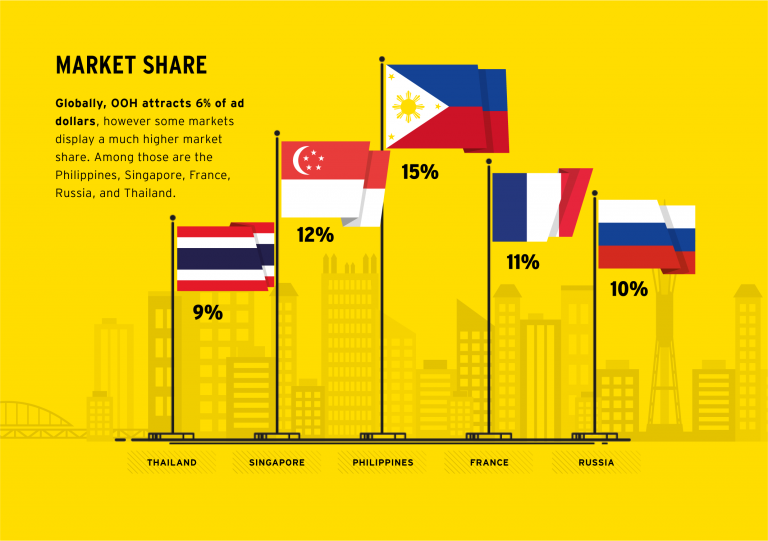
source: Campaign Asia
“The digital-out-of-home market is a return to advertising’s roots, quietly shifting the industry by way of re-imagining the classic advertising experience. Nearly $4.5 billion is expected to be spent on DOOH advertising in the U.S. by 2019, an increase of approximately $1.2 billion from 2016. Zenith forecasts that DOOH will grow faster globally than all other buying methods, and PricewaterhouseCoopers predicts that DOOH advertising revenues will overtake traditional media spend in 2020, growing at a rate of 15% a year for the next four years,” writes AdAge.com.
According to MAGNA, OOH advertising is now a $29 billion market, responsible for approximately 6% of the $500 billion global advertising spending. However, OOH market share increases to 10% to 12% in some countries, including France and Russia, compared with other media categories including Internet, TV, print and radio. OOH market share has remained stable in the last five years, hovering around 6%. However, as part of its increasing importance in the media mix, OOH market share has increased from 8% to 10% of traditional media advertising spend, which includes TV, print, radio and out-of-home, among other categories.
MAGNA Intelligence, in partnership with Rapport, conducted an in-depth survey in 22 key markets including Argentina, Australia, Belgium, Canada, China, Denmark, France, Germany, India, Italy, Japan, Malaysia, Mexico, Netherlands, Norway, Philippines, Russia, Singapore, Spain, Thailand, United Kingdom and the United States. The objective of the survey was to assess OOH advertising’s sustained growth and impact during a period where offline marketing budgets are stagnating and other media categories are struggling.
Moreover, MAGNA showed in another study launched in June, that in the USA, Out-of-Home (OOH) advertising is expected to grow +2% to $7.9 billion in 2017, including cinema. MAGNA reduces its 2017 growth forecast following weak first quarter advertising sales, which grew by just +0.3% in a sudden slowdown, as seven of the last eight quarters had shown year-over-year growth of +3% or more. The 1Q17 stagnation occurred as a result of several key verticals reducing spend, including both automotive and food & beverage, which both experienced double-digit declines. This offset the continued growth from tech brands (e.g. Google, Apple, Hulu and Netflix) that have driven OOH sales over the last two years.
The DOOH market encapsulates everything from digital billboards to screens in elevators to screens on jukeboxes. Unlike internet or mobile advertising, it allows advertisers to reach target audiences in a specific, real-world context. Instead of interrupting an internet user’s online experience with an ad, it’s focused on marketing to consumers when they are “on the go” in public places or in transit. Due to its specifications, the technology has the opportunity to give to its target the message in a format that’s automated, dynamic and interactive.
“The DOOH space presents a major opportunity for creatives, technologists and consumers alike. We see DOOH’s effectiveness in the numbers: the 2016 Nielsen OOH ad study found 91% of U.S. residents age 16 or older, who have traveled in a vehicle in the past month, noticed some form of OOH, and 79% noticed OOH in the past week. The same Nielsen digital billboards study found 71% of digital billboard viewers find those ads to stand out more than online ads. Ultimately, the emerging digital-out-of-home market is groundbreaking in its interactive technology, but it’s also a return to advertising’s roots and the original purpose around advertising: to provide an engaging and useful service to the public,” writes AdAge.
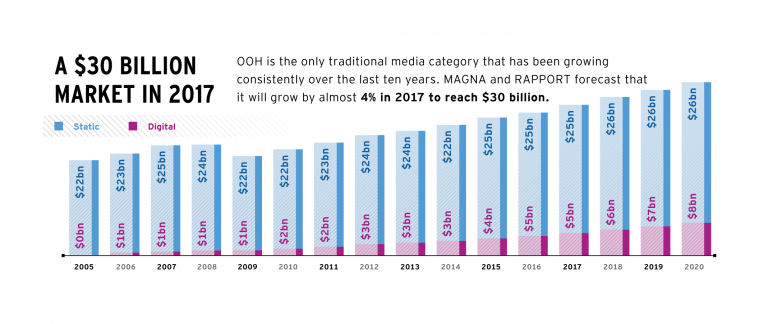
Globally, in 2016, the OOH market was worth $28 billion in net advertising, according to Magna’s report, and is predicted to grow by 4 percent per year to reach $33 billion by 2021. Behind this growth is an ever-more concentrated supply-side market, in which the top international OOH media owners are continuing to expand their influence: the six main global vendors (in order of 2016 revenue size, JCDecaux, Clear Channel, Outfront, Lamar, Stroer and Exterior) now control almost 40 percent of the whole market. By 2021, the report predicts small, but significant changes, in the environments most used for OOH. Use of billboards, currently the top revenue-generating segment and performing particularly well in India, Russia and the US, will drop 4 percent from 45 to 41 in the next five years. Street furniture and transit, meanwhile, are due to grow, respectively, from 31 to 34 percent and from 14 to 15 percent as local authorities become more willing to partner with OOH vendors. A series of major contracts—typically over 10 years long—in big cities are also in the process of renewal, the first time this has happened in the era of DOOH and programmatic opportunities, which partly explains DOOH’s recent giant revenue leap.
According to APAC, while the US is the largest OOH market, valued at $7.1 billion last year, APAC countries Japan ($4.7 billion) and China ($3.1 billion) come in at second and third position and per capita spending on OOH amounts to a record $38 per year in Japan, compared to $22 in the US. Singapore spends the second highest amount per capita at $36 a year. In the Philippines, meanwhile, OOH accounts for one of the highest percentage shares of overall ad spend in the world, at 15 percent compared to the global share of 6 percent. Singapore (12 percent) and Thailand (9 percent) also exceed the worldwide average.
Singapore’s OOH ads have the highest reach range of any other APAC market, with a penetration of 70 to 80 percent of the relevant population, due to its concentrated levels of urbanisation. Australia’s have the second highest, reaching 60 to 70 percent, but neither matches the reach of OOH ads in Argentina, which are considered seen by a huge 85 to 95 percent of the population.
In Australia, DOOH represents more than a third of total OOH spend, which the report attributes to a sophisticated advertising market and a population relatively concentrated in a few urban centers.
In China, the total OOH spend about matches other markets, it is one of the top five global markets in terms of penetration of digital, led by the transit segment. By 2021, MAGNA predicts that digital growth will have doubled, while OOH growth will be stagnating, partly due to lack of interest in non-digital inventory.
“OOH’s natural convergence with other digital media has hurt most other ad forms. OOH complements digital media by amplifying and enhancing it. This phenomenon has brought additional ad revenue to OOH, while most other media have experienced revenue losses as a result of the growth in digital.OOH has benefited from other new technologies, too, such as social media and mobile. Many OOH media campaigns are now picked up on social media, which greatly amplifies the total viewership. When consumers are on mobile devices, OOH is typically one of the last ad forms they’re exposed to just before important path-to-purchase decisions,” explained Steve Nicklin, Vice President of Marketing, OAAA, for billboardinsider.com.
The innovative opportunities provided by the digital platform have provided the OOH industry with new thinking and new ideas. Moreover, in the USA, as shown by the USA Touchpoints/RealityMine study, OOH and Today’s Mobile Consumer, consumers spend more time with OOH than any other form of advertising media except TV. The findings are supported by the 2016 Nielsen OOH ad study that found that 91% of US residents age 16 or older, who have traveled in a vehicle in the past month, noticed some form of OOH, and 79% have noticed OOH in the past week. Their research also discovered impressive levels of engagement, with 82% of billboard viewers reporting they look at the advertising message at least some of the time; and over one-third looking at the billboard ad each time or almost each time they noticed one. The Nielsen digital billboards study found 71% of digital billboard viewers find them to stand out more than online ads.
OOH is expanding to brand new environments. Digital screens have allowed OOH advertising vendors to penetration niche environment allowing to reach young urban population that is otherwise hard to reach by traditional media: offices, elevators, taxi, gyms, bars, retail etc. The “Digital Place-Based” segment offers targeting capabilities and programmatic opportunities. Moreover, OOH becomes addressable and experiments with programmatic. Initially developed to automate the trading of online display ads, the programmatic technologies are now being used in to buy and optimize ad campaigns on connected DOOH units.
Programmatic techniques not only optimize the workflow of media-buying but help brands deliver the right ad in the right place and at the right time, using consumer data and mobile location data. Giving advertisers the ability to plan, buy, optimize and measure the effectiveness of their outdoor campaigns through an online platform represents the natural evolution of OOH’s technology-driven transformation with many vendors developing Private Marketplaces (PMP).
Besides that, DOOH is going social. “There are two main avenues DOOH is being used to complement social campaigns, either through integration or through content creation,” says Neil Morris, founder and CEO of UK-based creative production house Grand Visual.
12 tips on making the customers buy more in online
The e-commerce industry is probably one of the most competitive at this moment, globally. Therefore, having a successful online shop is not an easy task at all, let alone always growing your business and your customers’ base. There are, although, some steps that, if followed, can really help you achieve your goal.
- Context MattersYour call to action has to fit in with the rest of the copy you have on the page. In this case, put a shopping-cart-related call to action on a page that talks up the product you’ve created or in an article talking about how your product solves a particular problem. It would not go well in an opinion piece about news within your niche.
- Keep it Simple
Your consumer need to find the right information fast. Don’t overcrowd the message by having a heavy environment or many information popping out. It’s important to make the consumer journey as fast and easy as possible. Nothing forced, just flowing. Guide him without letting him feel he is guided. The body of your copy is the place to talk up your products or services. The call to action is what convinces consumers to start shopping.
- Product reviews
Sometimes the best advocate for your online shop and product are your customers. Your product descriptions – something we’ll cover late – can only do so much to convince folks to part with their money. Allowing your customers to review products they’ve bought lets them express how they felt about the overall experience and the product itself. Plus it’s the perfect way to get your products validated by a third party. According to Reevoo, quoted by Paymill.com, “reviews produce an average 18% increase in sales, and having 50 or more reviews on a product can increase its conversion by 4.6%”, while MarketingSherpa considers that 58% of consumers prefer sites that offer reviews.
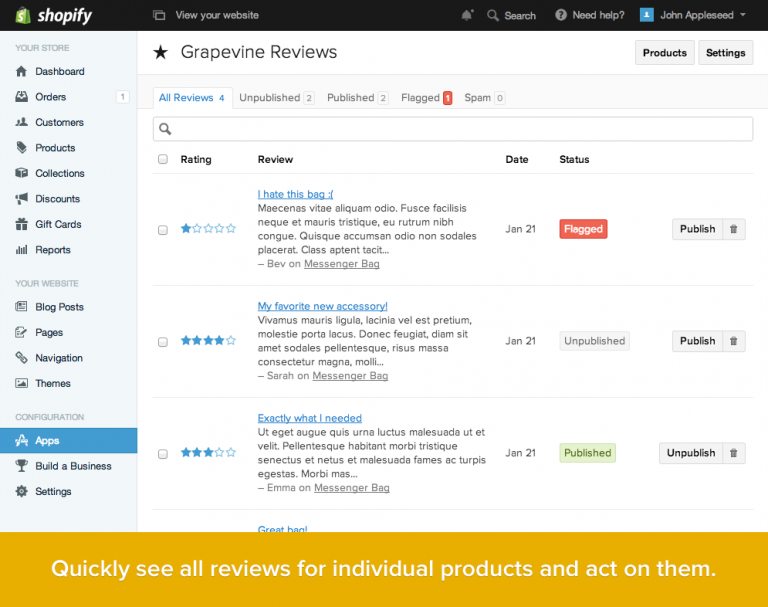
- Placement Matters
Most of the time, a call to action works best when placed at the end of your copy or content. If your particular business makes use of the long-form sales page, putting the call to action higher up is a good idea. You can highlight the benefits of your products and encourage people to buy.
- Make sure you use quality images
Since the technology has evolved so far and one can take a great quality picture, at a high resolution, even with the smartphone there are no more excuses for not using the best pictures possible for your products. You can not only use images to highlight your product’s qualities, but also show it in use to help visitors visualize how the product can be used everyday.

- Great product descriptions
Making it easy for the customers to find the right information and teaching them about the product they are interested in. The writing should be focused on you target and its needs, therefore the tone of voice should be adapted to that. It’s important to focus on the product’s benefits and to keep the language simple, avoiding as much as possible the jargon and write short sentences to help the readability.
- Build Excitement
You need to build up the product or line of products in customers’ minds before asking them to buy. This way, there won’t be any doubt about if they want to take the action you’re calling on them to take. Talk about or show how beneficial what you’re selling can be in the buyer’s life.
- Be Active, Not Passive
“It would be nice if you bought my stuff” is not the same as “Click here to start shopping.” Passive implies that you aren’t sure if you want them to do the thing you’re asking them to do. Active voice removes all doubt about your expectations, shows confidence in your products and brands, which it will bring confidence for the customers as well.
9. Try and have pages as clickable as possible
It helps if you make your call to action an actual clickable link — preferably to your shopping cart (which can say something like “Cart empty! Start shopping here”). This saves the viewer the time of searching for the thing that helps them do what you want them to do. As said earlier, making things easier and comfortable for the shopper only helps your business and your sales.
- Show related products that would look great next to the product they already have in the cart or that would fit perfectly. For example for a photo camera a memory card or different lenses. People tend to buy more this way. It’s an opportunity to increase revenue because it shows items visitors may not have otherwise been looking for and it takes them to pages they may haven’t been interested in entering.
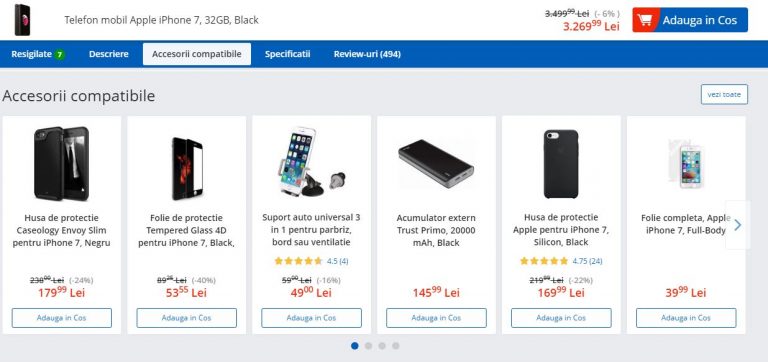
- Easy and safe payment
One of the biggest concerns that people address when it comes to online shopping is the safety of their payment. Make sure you have a trustful provider and that you make the process as easy as possible. Offer them different payment methods, don’t force them to sign up for different offers or newsletters, don’t ask them a bunch of unnecessary information, make sure the checkout page matches the rest of the store. Those would be just some easy, but really important pieces of advice.
- Test, Change, Test Again
Having an online store means constant work of improvement. Even if you have constant growth and awards won, there is always something you can improve. Therefore, test and keep on always testing your website. After all, the final goal is to always keep the costumer happy and wanting to come back and bring more friends along.
What makes a video viral?
Creating a successful viral campaign is every marketer’s dream nowadays and many agencies aspire to the idea of creating a video that will have a huge impact on the target and will get shared fast and, therefore, create a big buzz around it. But what is a viral video and how hard is to reach that goal? According to the definition on techopedia, a viral video is any clip of animation or film that is spread rapidly through online sharing. Viral videos can receive millions of views as they are shared on social media sites, reposted to blogs, sent in emails and so on. Most viral videos contain humor and fall into three broad categories:
- Unintentional Viral Videos: Videos that the creators never intended to go viral. These videos may have been posted by the creator or shared with friends, who then spread the content.
- Humorous Viral Videos: Videos that have been created specifically to entertain people. If a video is funny enough, it will spread.
- Promotional Viral videos: Videos that are designed to go viral with a marketing message to raise brand awareness. Promotional viral videos fall under viral marketing practices.
When it comes to the formula of creating a viral, it hasn’t been determined or shared yet, leaving us thinking that some of the success it has to do with luck and that most things actually go viral by accident. Very few people have mastered the art of creating viral content on purpose. What is for sure known is that it has to appeal to the target’s emotions, no matter their type (happiness, sadness, anger, joy, love, etc).
“Viral videos are the talk of the town—garnering coverage on popular blogs, rising to the top of sites like Reddit, being Tweeted and posted to Facebook, and even covered on the evening news,” wrote Megan O’Neill for AdWeek.
“There’s no specific number of shares, likes, retweets, reblogs, or whatever another measure of interaction needed to be reached in order for it to claim “viral” status. On YouTube, lots of videos get tens of thousands of views now shortly after being uploaded, but many people wouldn’t say that’s enough to consider it viral. Back in the day, however, when YouTube was much smaller and there weren’t as many users uploading videos, tens of thousands of views may have counted as <<going viral>>,” said Elise Moreau for Lifewire.
Moreover, advanced technology and platform design have made it way too easy to share things with our friends and followers, making the perfect environment for a ripple effect to occur on all levels of social media with the perfect piece of shareable content. All it takes is a few shares and the right audience to trigger an avalanche of sharing across the internet. It’s not easy to start a viral movement, but when it does happen, it can take the most regular people and turn them into internet celebrities practically overnight if it’s powerful enough.
According to Jonah Berger, marketing professor at the Wharton School at the University of Pennsylvania and author of “Contagious: Why Things Catch On”, quoted by entrepreneur.com, visceral response is what separates viral breakouts from busts. Berger has spent years investigating the mechanics behind virality, identifying six key drivers under the acronym STEPPS. They are Social Currency (e.g., sharing things that make people look good), Triggers (acknowledging that we talk about things that are top-of-mind), Emotion, Public (imitating what we see others do), Practical Value (news people can use) and Stories (information passed along under the guise of idle chitchat). “Each [driver] is a research-tested principle that increases the likelihood that people will talk about and share things, that brands get word-of-mouth, that services get shared and that videos get passed along the internet,” Berger explains. “We can reliably say that including certain characteristics and messages will increase the number of people who share [content] and the likelihood it will be shared.”
How To Write An Email That Actually Sells
When writing a business email the line between too little and too much may be very small, therefore is important to pay attention to some of the advices that the specialists offered during the years into how to write a successful email.
Being yourself in emails can bring you more long-term response than any other email tip, tactic or “technique” combined. Let your unique personality shine through in every word. Showing your partners the real you, will take you far. The business people are fed up of receiving robotic- mechanical email, full of the same key phrases that actually don’t say a thing. Introduce yourself, and your company, right away. Existing customers will greet you like an old friend, while potential shoppers won’t be forced to wonder if you are a shady scam artist.
Target your message to the right audience. Never forget what you are selling and to whom you are selling it. Remember that even the best crafted pitch is worthless if it’s delivered to someone who doesn’t want it.
Get to the point. According to Jupiter Communications research, only 15 percent of web users read all email messages in their entirety. More than half (51.2 percent) read the first few sentences and then decide whether or not to continue. Forcing your customer to wade through paragraphs of superfluous information is the quickest route to the delete key and to the death of a sale.
Be clear. Make sure that the information is presented in a clear matter. Use paragraphs, bold words, to highlight the most important part of the content and make sure it stands out and is not forgotten. Moreover, avoid the temptation to be too sophisticated in your design. Many systems still won’t support fancy formatting. Plus, most of it gets lost on the trip through the network anyway. Keep it easy on the eye.

Be an editor. Your customer needs to know he is buying from the best. Proofread. Break up run-on sentences. Use simple language. Catchy phrases don’t make up for sloppy punctuation and typos. And if you can’t write, hire someone who can.
Try a joke. Nothing works better than a good sense of humor, use at the right time and with the right amount of spice. Not an easy to do task at all, but one that proved to be quite efficient in time.
Tell stories. Stories are a great way to sell in emails, no matter the brand of the product or the service you are trying to pitch. If you succeeded in making the other side drawn into your story, then for sure you have a winning email. The reason is quite simple: people like to be emerged easily into the content, to be charmed, not to have the impression even from the beginning that you want to sell them something or the fact that this is your plan all along. Let the person reading the email be entertained, carried through the layers of the email and the information you are providing him. It will be much easy to be processed and understood.
And, in many cases, it’s the most persuasive way to get someone to do what you want. Whether it’s persuading someone to buy your product or persuading a child to be careful of talking to strangers — stories inspire and motivate people to take action.
Personalize it. Make sure you know to whom you are writing and address it accordingly, by name and position. Few things are more annoying that receiving a “bulk” email, addressed wrongly. Knowing a little about the person you are writing to and making sure you are saying it gets you a long way on the selling process.
The guys at hubspot.com give you even more ideas here.


